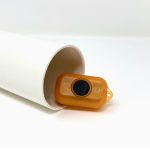What’s The Deal With All These Frequencies?
It “Hertz” so much you are “Kilo-ing” me!
Well, let’s talk about how fast things vibrate or repeat themselves – these are called frequencies and are measured in Hertz. Imagine seeing sound waves moving or computer chips working fast; these measurements in Hertz help us understand all that magic. Here are the four Prototek Frequencies that can be found in our flushable and durasonde Transmitters.
16 Hertz (16 Hz) – This is a slow, steady drum beat. A low sound, like a deep bass, that you can feel more than you hear. Prototek’s LD-9 DuraSonde 16 Hz frequency is for environments with steel, ductile iron, and cast iron. 16 Hz is used with Steel, Cast Iron, and Ductile because with such a low frequency, 16 Hertz can go through and around things that the other frequencies just can’t.

512 Hertz (512 Hz)– This is playing the guitar like you were ringing a bell. It’s much quicker than that previous drum. It’s higher, and you can hear it. This sound is clearer and can be used to tune instruments in music. This is the United States industry standard frequency. If you used to buy our Amazon Prime 3-pack of Blue Prototek FTP-8 flushable transmitters, you were getting 512 Hz. This frequency can also go through cast iron and ductile iron but not to the depth and range of 16 Hz. Prototek has 5 different options of 512 Hz flushable and DuraSonde transmitters, including the very popular FD-20 as well as the very recognizable little blue flushable pill, our Amazon Famous FTP-8.

512 Hertz Bell
8 Kilohertz (8 kHz) – We’ve just jumped into hummingbird wing and helicopter blade rotation territory—super fast! 8 kHz is what we’d call the territory of everyday sounds we hear, like some human speech or a telephone ring. At this speed, vibrations are much quicker, and the sounds are much higher than our 512 Hz bell. The frequency can’t go through cast iron, ductile iron, and steel, but it does get the longest depth and range in non-metallic environments and is fast enough to cut through other electronic interference. This frequency can be found in Prototek’s Next Generation Flushable Transmitter, the HTP-15, as well as the HD-40 and HD-80.

223 Kilohertz (223 kHz) – This speed is like a superhero of frequencies, way beyond what our ears can hear. It’s used in high-tech stuff, like sending signals for TV or radio, maybe even for controlling drones! It’s so fast that it’s no longer about sound but sending data through the air. Prototek exclusively uses this proprietary frequency solely on its Hunter Orange AR-223 line of the Ardy receiver / locator and its little orange flushable transmitters counterpart, Prototek’s ATP-12.

So, from the slow beat of 16 Hz to the super-fast digital world of 223 kHz, frequencies tell us a lot about the world, from the sounds we enjoy to the technology we rely on daily. With Prototek’s wide array of underground locating frequencies, we make it easy to Find It The First Time!

Well, what in the world is the difference between Hertz, Kilohertz, Megahertz and Gigahertz?

Have you ever watched a NASCAR race or one of those fancy F1’s? Picture yourself as a driver on a track, where each lap you run represents a cycle. The number of laps you drive in a second is similar to the concept of frequency measured in hertz (Hz), kilohertz (kHz), megahertz (MHz), and gigahertz (GHz). It’s all about the frequency of something happening in a second.

Hertz (Hz) is the fundamental unit of frequency. When something occurs once per second, it’s at 1 Hz, just like driving one lap in one second. As the slowest measurement of frequency, it is amazing to realize how fast just one hertz is. We used to be able to drive that fast back in the day when we could really open ‘er up, huh? Seriously though, Prototek’s LD-9 16 Hertz for Steel, Cast, and Ductile environments, plus all of our 512 Hertz transmitters, operate in this range.

Kilohertz (kHz) represents a thousand hertz. If you could drive 1,000 laps in a second (impressive, right?), that’s moving at 1 kHz. It’s used for things that happen thousands of times per second, like certain radio frequencies or Prototek’s 8 kHz HTP-15 or the 223 kHz ATP-12 flushable transmitters.

Megahertz (MHz) cranks it up to a million hertz. Imagine Dale Jr. or Danica driving 1,000,000 laps in one second – that’s 1 MHz. This is the speed of computer processors or the radio frequency bands your favorite FM station broadcasts on, not Prototek’s transmitters!

Dale Jr: “100%”
Gigahertz (GHz) stands at a billion hertz. Driving 1,000,000,000 laps in one second would mean moving at 1 GHz (quite impossible for a human, but let’s pretend). This is the speed at which the most powerful computer processors operate, handling billions of cycles every second.

Moving from hertz to gigahertz, we transcend from once-per-second events to things happening billions of times per second. It’s like going from driving two miles an hour to teleporting around the track! Each term enables us to measure just how rapidly electronic devices and waves are moving. Hope this helps, Happy Locating!



